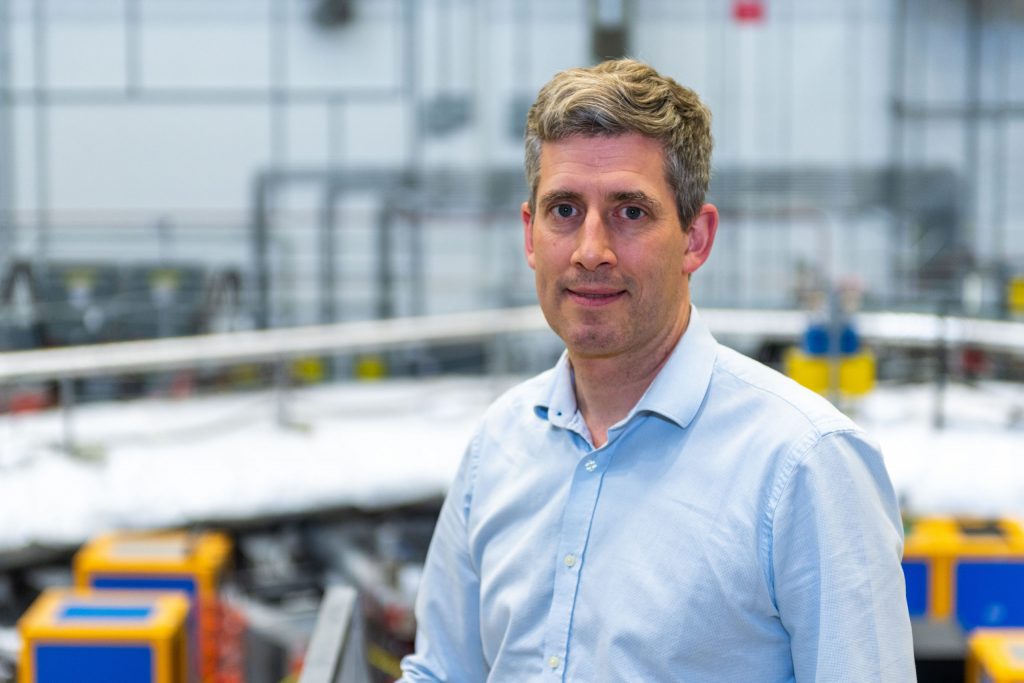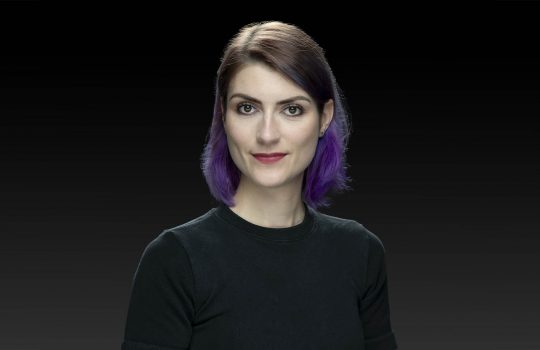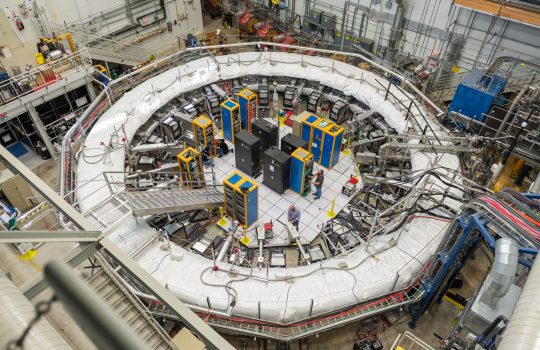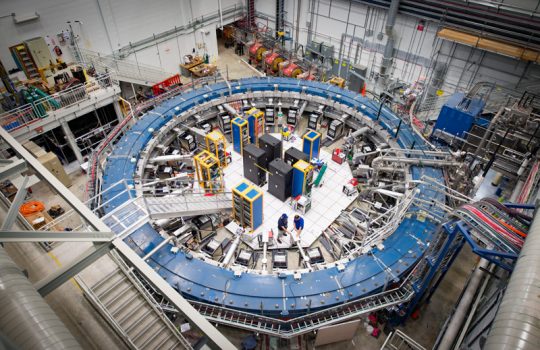When serving as a spokesperson, physicist Peter Winter knows it’s just as important to listen to fellow scientists as to speak. Now the newly named co-spokesperson of the Muon g-2 collaboration, Winter will bring to bear his experience in leadership, collaboration and inclusion as the experiment shifts into its final phases of data analysis.
After earning his doctorate in physics with a thesis at the Forschungszentrum Jülich in Germany, Winter began his work on muons during his postdoctoral research at the University of Illinois Urbana-Champaign and the University of Washington. He joined the Muon g-2 experiment 12 years ago, right before he was hired at Argonne National Laboratory in 2012.
The Muon g-2 experiment seeks to measure the spin behavior of muons, an elementary particle similar to electrons but more massive, in a magnetic field. The Standard Model, the current understanding of particle physics, offers a prediction for the value of one of the quantities involved with muons’ spin in a magnetic field. This quantity, the gyromagnetic factor, is designated as g. At the simplest level, theory predicts that g is equal to 2, with a 10th of a percent increase due to the quantum fluctuations of the electromagnetic field around the muon. Comparing the discrepancy between the theorized value and the actual observed value could hint at physics phenomena beyond the Standard Model.

Argonne National Laboratory physicist Peter Winter brings his experience with managing and collaborating among the researchers of the Muon g-2 experiment to the position of spokesperson. Photo: Ryan Postel, Fermilab
“By comparing the two, we can understand if our theoretical understanding is complete, or if there are new particles or forces that might be needed to describe the discrepancy,” Winter said. “There’s currently a discrepancy between the recommended theoretical value and the experimental value, and that is a tantalizing hint at possibly new physics that we would like to understand.”
Such a discrepancy was potentially observed at Brookhaven National Laboratory in the early 2000s. The goal of the Muon g-2 experiment at Fermilab is to use its higher precision to confirm or refute this discrepancy.
“By measuring, very precisely, the way in which the muon interacts in the magnetic field, we can get information on the completeness of the Standard Model,” said Graziano Venanzoni, the other co-spokesperson for Muon g-2.
Nearly 200 people from seven countries and 34 institutions work on Muon g-2. Serving as a spokesperson for so many collaborating scientists is both exciting and challenging, said Venanzoni, a physicist with University of Liverpool and the Italian National Institute for Nuclear Physics, Pisa. It’s important to foster a healthy environment where the scientists in the collaboration feel recognized and included, Venanzoni added.
“All these people work to measure one single quantity,” he said.
Winter already has experience with coordinating members of the collaboration, and Venanzoni can vouch for his kind, effective approach to working with others. He also added that Winter knows the importance of mentoring and supporting early career scientists. Winter prioritizes diversity and inclusion in the Muon g-2 collaboration, which helps the collaboration thrive.
“Peter not only is an excellent scientist who already gave many important contributions to the experiment, but he’s also a very nice, very pleasant person,” Venanzoni said. “He has a priority to have an inclusive collaboration and to give support to the early career scientists.”
Winter said it’s important to make sure that many people come together and are involved in the experiment, including scientists at all stages of their careers. This includes providing opportunities for everyone to bring their insights to look for new ideas and solutions.
“We have many young scientists on the experiment that do a lot of the analysis and a lot of the operations,” he said. “They are essential, and you want to make sure that all of them feel included in the experiment, because if they don’t, they cannot develop their full potential.”
Muon g-2 faces a couple of momentous milestones this summer. Its final period of data collection wrapped up in July. Later this summer, the next round of results from the experiment are slated for release.
“With that, the focus lies on getting the more than half of the remaining data analyzed,” Winter said, “because that will give us another factor of about two in increased precision, and lead to the ultimate goal that we had set out to reach more than 10 years ago.”
Because the new result this summer will be the second analysis from Muon g-2, this round of results will provide an opportunity to compare it against the experiment’s own first result, not only against the results from the Brookhaven experiment, Winter said.
The upcoming data sample will be four times larger than the first batch of results, which already made a huge splash internationally in 2021, Venanzoni said, and twice as precise.
“The name of the game here is really precision,” he said. “The more precisely you do a measurement, the better chance you have to discover something new. Since the Standard Model prediction is very precise, our measurement also has to be very precise.”
It will still take a couple of years to analyze the rest of the data from the last data collection runs of Muon g-2, Venanzoni said, which will increase precision even further. The role of spokesperson will focus on managing the teams analyzing the data, Winter said.
“This role now shifts a bit, because the operation of the experiment has come to a close as we finished the last days of data-taking,” he said. “That role is certainly focused on bringing in the analysis teams and making sure we get our final result out in a timely manner.”
Over the years of working on Muon g-2, Winter said he has enjoyed the diversity of not only the contributing scientists, but the physics problems that the experiment presents. This lets Winter learn new things all the time by working with experts from different specialties. In particular, he now works on the team that measures the magnetic field of the experiment’s storage ring.
“It has been a really fantastic journey because I had the pleasure of working from the beginning: from early stages, through the design and construction, to the first data-taking, and now we are close to the end where we are finally working on the analysis of all the big datasets that we’ve collected,” he said. “I’m very honored to be in this new role and looking forward to working with the whole collaboration.”
Learn more about the Muon g-2 experiment.
The Muon g-2 experiment is supported by the Department of Energy Office of Science.
Fermi National Accelerator Laboratory is supported by the Office of Science of the U.S. Department of Energy. The Office of Science is the single largest supporter of basic research in the physical sciences in the United States and is working to address some of the most pressing challenges of our time. For more information, please visit science.energy.gov.



